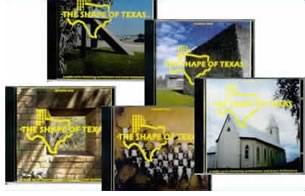

Public Radio Program Defines the Shape of Texas
by
Tracy F. Ostroff
Associate Editor
 Elizabeth
Chu Richter, AIA, has long harbored a desire to share her love of architecture,
elevate public awareness of the built environment, and raise the profession’s
profile across her home state. Her resulting labor of love is The
Shape of Texas, a public radio program that offers travelers and
other listeners a personal guide to contemporary and historical architecture
and places exemplifying the culture and heritage of the Lone Star State.
Elizabeth
Chu Richter, AIA, has long harbored a desire to share her love of architecture,
elevate public awareness of the built environment, and raise the profession’s
profile across her home state. Her resulting labor of love is The
Shape of Texas, a public radio program that offers travelers and
other listeners a personal guide to contemporary and historical architecture
and places exemplifying the culture and heritage of the Lone Star State.
The program, now in its fourth year, features two-minute spots on buildings and places statewide that are accessible to the public. The latest volume, for example, included reports on the Monte Vista National Historic District, San Antonio; River Oaks Park, Houston; a general feature on billboard architecture; and the La Lomita Chapel in Mission. Each episode, Richter said, paints a succinct, vivid picture of the subject, having an advantage over video because it does not include a prepared visual element to “stop-short” the imagination.
Richter said she developed the Shape of Texas, which was awarded a 2003 AIA Component Award for Excellence, to “help raise awareness of the value of architecture in defining our heritage, our legacy, and civilization.” The architect, a principal with her husband David Richter, FAIA, in the award-winning firm of Richter Architects in Corpus Christi, is a determined and indefatigable advocate for architecture. Now the vice president-Public Activities Comission of the Texas Society of Architects (TSA), in 1999, at 51, she was the first Texan to receive the AIA’s Young Architect’s award, an honor that recognizes time in practice regardless of age. Last year the Corpus Christi Caller-Times named her its “Newsmaker of the Year.”
Shape of Texas
takes form
As Richter embarked on the project, she looked for a medium that would
be affordable and capture a broad range of listeners. For that she turned
to public radio, a field in which she was involved as a volunteer on the
board of the South Texas Public Broadcasting System, which owned PBS television
stations and NPR affiliate radio stations. Richter said she had several
objectives when the program hit the airwaves in 1999. “One is, of
course, to illustrate that how and what we build can really affect the
way we live, work, and play.” She noted the program’s efforts
are bearing fruit, with listeners e-mailing to say they have been inspired
to travel within their hometowns or to venture further to see for themselves
the locales described in the broadcasts. Another goal, Richter said, was
to “cultivate an inquisitive public and to encourage real-time architectural
experience through travel.” She also said she thought that the Shape
of Texas “could very well be something that can be duplicated
by all the AIA chapters, because they too can use this as an outreach
in their cities.”
 Richter
and a small team produce a volume of 26 episodes every five to six months.
The library now includes 9 volumes with 234 episodes. Under the guidance
of co-executive producers Richter and Don Dunlap, general manager of KEDT
in Corpus Christi, journalist Lauraine Miller produces and edits the program,
and about 15 writers, including architects, journalists, and academics,
contribute scripts. “We have them located throughout the state to
save traveling costs. We certainly want everybody to visit the place they
are going to write about.” Soon, the Content Advisory Committee,
which includes TSA members, radio station representatives, and outside
public members, will gather to select the pieces that will be featured
on volume 10. Richter said Bill Clough from KEDT, will narrate the program
at the studio in late summer.
Richter
and a small team produce a volume of 26 episodes every five to six months.
The library now includes 9 volumes with 234 episodes. Under the guidance
of co-executive producers Richter and Don Dunlap, general manager of KEDT
in Corpus Christi, journalist Lauraine Miller produces and edits the program,
and about 15 writers, including architects, journalists, and academics,
contribute scripts. “We have them located throughout the state to
save traveling costs. We certainly want everybody to visit the place they
are going to write about.” Soon, the Content Advisory Committee,
which includes TSA members, radio station representatives, and outside
public members, will gather to select the pieces that will be featured
on volume 10. Richter said Bill Clough from KEDT, will narrate the program
at the studio in late summer.
The Shape of Texas airs on some 15 National Public Radio affiliates statewide, so each CD "is not just focused in on any one city or region because we want to keep that diversity in building types and geographic diversity as well.” Richter sends the CD to the radio stations without charge, at which point they can choose to air it at regular time slots or “drop it in” when they have flexibility in their programming schedules and repeat as often as they want. In the Dallas-Fort Worth area, for example, the station plays it five nights a week. Other stations play it three days a week, and many play it during Morning Edition, All Things Considered, or Car Talk. “The episodes are 'evergreen' so that they can be played at any time and repeated as often as desired. The timeless quality also makes it easy for additional stations to come on board,” Richter said.
Besides being the creator and executive producer, Richter is also the chief fundraiser for the show, which costs about $60,000 for two volumes, or 52 episodes. Several underwriters helped Richter develop the main body of work. The TSA is a major funding source. She has also received contributions from the AIA, the American Architectural Foundation, and the College of Fellows. The program has also received funding from Texas Highways magazine, Best Western Motels, and, most recently, Acme Brick Company of Fort Worth.
 Life
beyond radio
Life
beyond radio
“It was very important that all these episodes be timeless so that
they can play them as often as they want to and it would still be relevant,”
Richter said. However, the production team is also looking toward the
future. “One of the things, too, is that the program is considered
to be a body of work that can be used in other ways besides radio.”
The programs are used in schools—it’s been used as a teaching tool in an architecture cluster at a high school in Dallas—and as a research resource on the state’s history. It also has potential, Richter said, to be used as a supplement in museums or be repackaged by regions or cities as a visitor’s guide or for residents who want to learn more about their heritage.
Richter observed that the radio spots also serve to reinforce the AIA’s national advertising campaign and the branding efforts under way at the Institute. For example, the program will mention the architects name and if it the project has received any AIA awards. Local architects and firms also have the opportunity to underwrite the programs that run on their local affiliate, which provides a welcome source of funding for local stations—it does not go toward funding program’s production—and exposure for the designers.
Medium provides maximum impact
Radio is a particularly appropriate medium, Richter noted, because Americans,
and perhaps listeners in the large state of Texas, increasingly spend
a lot of time in cars. “You’re sort of a captive audience,
and it’s a very personal medium. What better way is there to connect
what you hear with what you’re driving through, whether it be in
the cities or in the countryside, and you see something there that has
some application with what we’re talking about on that particular
episode?”
Marketing estimates convey that the show is developing a following. According to Richter, Acme Brick approximates that the program delivered between 2.2 to 3 million impressions in 2002, based on the frequency of play at the various participating stations. “We just think it’s a good audience,” Richter said. “We’re just so thrilled that the public is responding well to it.” She said she hears from people who say, ‘You know, I feel like I can talk about architecture now that I know some of these terms.’” She said one teacher mentioned to a fellow architect, “Now that I know what an entablature is, I feel like I can talk about it with my kids at school.”
![]() Click here to listen to an episode on the Garten Verein in Galveston.
Click here to listen to an episode on the Garten Verein in Galveston.
![]() Click here to listen to a program on curtainwalls.
Click here to listen to a program on curtainwalls.
![]() Click here to listen to a program on el Barrio Azteca in Laredo.
Click here to listen to a program on el Barrio Azteca in Laredo.
Copyright 2003 The American
Institute of Architects. All rights reserved. Home Page ![]()
![]()
 |
||
| •
Click here to visit
The Shape of Texas Web site.
|
||